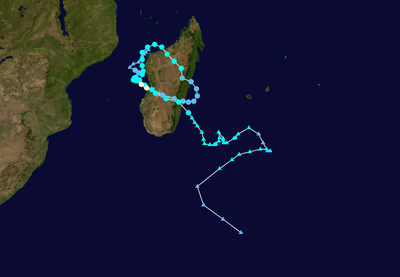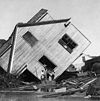
Back بوابة:طقس Arabic دەروازە:کەش و ھەوا CKB Portál:Meteorologie Czech Portal:Wetter und Klima German Portail:Météorologie French Portale:Meteorologia Italian Portal:気象と気候 Japanese 포털:날씨 Korean Portāls:Meteoroloģija Latvian/Lettish Portal:Pogoda Polish
The weather portal
Weather is the state of the atmosphere, describing for example the degree to which it is hot or cold, wet or dry, calm or stormy, clear or cloudy. On Earth, most weather phenomena occur in the lowest layer of the planet's atmosphere, the troposphere, just below the stratosphere. Weather refers to day-to-day temperature, precipitation, and other atmospheric conditions, whereas climate is the term for the averaging of atmospheric conditions over longer periods of time. When used without qualification, "weather" is generally understood to mean the weather of Earth.
Weather is driven by air pressure, temperature, and moisture differences between one place and another. These differences can occur due to the Sun's angle at any particular spot, which varies with latitude. The strong temperature contrast between polar and tropical air gives rise to the largest scale atmospheric circulations: the Hadley cell, the Ferrel cell, the polar cell, and the jet stream. Weather systems in the middle latitudes, such as extratropical cyclones, are caused by instabilities of the jet streamflow. Because Earth's axis is tilted relative to its orbital plane (called the ecliptic), sunlight is incident at different angles at different times of the year. On Earth's surface, temperatures usually range ±40 °C (−40 °F to 104 °F) annually. Over thousands of years, changes in Earth's orbit can affect the amount and distribution of solar energy received by Earth, thus influencing long-term climate and global climate change.
Surface temperature differences in turn cause pressure differences. Higher altitudes are cooler than lower altitudes, as most atmospheric heating is due to contact with the Earth's surface while radiative losses to space are mostly constant. Weather forecasting is the application of science and technology to predict the state of the atmosphere for a future time and a given location. Earth's weather system is a chaotic system; as a result, small changes to one part of the system can grow to have large effects on the system as a whole. Human attempts to control the weather have occurred throughout history, and there is evidence that human activities such as agriculture and industry have modified weather patterns.
Studying how the weather works on other planets has been helpful in understanding how weather works on Earth. A famous landmark in the Solar System, Jupiter's Great Red Spot, is an anticyclonic storm known to have existed for at least 300 years. However, the weather is not limited to planetary bodies. A star's corona is constantly being lost to space, creating what is essentially a very thin atmosphere throughout the Solar System. The movement of mass ejected from the Sun is known as the solar wind. (Full article...)
Selected article
Cyclone Elita was an unusual tropical cyclone that made landfall on Madagascar three times. The fifth named storm of the 2003–04 South-West Indian Ocean cyclone season, Elita developed on January 24 in the Mozambique Channel. It strengthened to become a tropical cyclone before striking northwestern Madagascar on January 28. Elita weakened to tropical depression status while crossing the island, and after exiting into the southwest Indian Ocean it turned to the west and moved ashore for a second time on January 31 in eastern Madagascar. After crossing the island, the cyclone intensified again after reaching the Mozambique Channel, and Elita turned to the southeast to make its final landfall on February 3 along southwestern Madagascar. By February 5 it had undergone extratropical transition, and the remnants of Elita moved erratically before dissipating on February 13.
Elita dropped heavy rainfall of over 200 mm (8 inches), which damaged or destroyed thousands of houses in Madagascar. Over 50,000 people were left homeless, primarily in Mahajanga and Toliara provinces. Flooding from the storm damaged or destroyed more than 450 km² (170 sq mi) of agricultural land, including important crops for food. Across the island, the cyclone caused at least 33 deaths, with its impact further compounded by Cyclone Gafilo about two months later. Elsewhere, the cyclone brought rainfall and damage to Mozambique and Malawi, while its outer circulation produced rough seas and strong winds in Seychelles, Mauritius, and Réunion.

Recently selected articles: Winter service vehicle, Hurricane Mitch, More...
Did you know (auto-generated) -

- ... that an attempted British-Norwegian attack on the German battleship Tirpitz was abandoned after two Chariot manned torpedoes were lost due to bad weather?
- ... that extreme event attribution estimates how much climate change causes weather events, such as the 2021 Western North America heat wave?
- ... that Japanese actor Kouhei Higuchi prepared for his role on the television drama adaptation of My Personal Weatherman by learning from a weather forecaster?
- ... that Eric Berger wrote about weather for the Houston Chronicle even before he became a certified meteorologist?
- ... that the weather forecast for HD 189733 b is "Westerly winds at 2000 m/s, with molten glass showers"?
- ... that weather whiplash is the phenomenon of rapid swings between extremes of weather conditions?
Selected image

Recently selected pictures:
More did you know...
...that the Flying river is the name given to the transport of water vapor from the Amazon rainforest to southern Brazil?
...that hurricane shutters are required for all homes in Florida unless impact-resistant glass is used?
...that the Joint Institute for Marine and Atmospheric Research is a combined weather and ocean research institute with the cooperation of the Office of Oceanic and Atmospheric Research and the University of Hawaiʻi?
...that the SS Central America was sunk by a hurricane while carrying more than 30,000 pounds (13,600 kg) of gold, contributing to the Panic of 1857?
...that a hurricane force wind warning is issued by the United States National Weather Service for storms that are not tropical cyclones but are expected to produce hurricane-force winds (65 knots (75 mph; 120 km/h) or higher)?
...that the Automated Tropical Cyclone Forecasting System is a software package for tropical cyclone forecasting developed in 1988 that is still used today by meteorologists in various branches of the US Government?
Recent and ongoing weather
- Wikinews weather portal
- March 26, 2021: Tropical moisture ceases to cause severe floods in South East Australia
- February 19, 2021: Winter storms hammer Texas, fatalities reported
- December 28, 2021: Typhoon Phanfone strikes Philippines
- February 1, 2022: Deadly floods in Brazil after heavy rainfall
- April 15, 2022: South African floods kill at least 300 people
- Weather of 2024
- 2024 Atlantic hurricane season
- 2020–21 North American winter
- 2024 Pacific typhoon season
- Tornadoes of 2024
This week in weather history...
July 26
2005: Almost 1,000 millimeters (39 in) of rain in just 24 hours caused severe flooding in the Indian state of Maharashtra, killing more than 1000 people.
July 27
1989: Typhoon Judy struck southern Kyushu, Japan, killing 11 people in the country due to significant flooding and landslides.
July 28
1996: Hurricane Cesar made landfall in Nicaragua and moved across Central America. Due to different conventions in the eastern Pacific Ocean, the storm was renamed "Douglas".
July 29
1904: The first section of the Galveston Seawall was completed.
July 30
1978: Tropical Storm Amelia formed just off the coast of southern Texas. Upon moving inland the next day, Amelia caused severe flooding which killed 30 people.
July 31
2022: A volcano warning is accidentally issued for a wildfire in Scotts Bluff County, Nebraska.
August 1
1913: Ragnar Fjørtoft, a meteorologist who did pioneering work in numerical weather prediction, was born in Oslo, Norway.
Selected biography
Robert H. Simpson (November 19, 1912 – December 18, 2014) was an American meteorologist, hurricane specialist, first director of the National Hurricane Research Project (NHRP) from 1955 to 1959, and a former director (1967–1974) of the National Hurricane Center (NHC). He was the co-developer of the Saffir–Simpson Hurricane Scale with Herbert Saffir. His wife was Joanne Simpson. (Full article...)
Previously selected biographies: William Ferrel, John Dalton, More...
Related portals
Quality content
Other candidates:
- Featured Article Review: 2005 Atlantic hurricane season (Discussion)
- Featured List Removal Candidate: List of storms in the 2005 Atlantic hurricane season (Discussion)
Subcategories
WikiProjects
The scope of WikiProject Weather is to have a single location for all weather-related articles on Wikipedia.
WikiProject Meteorology is a collaborative effort by dozens of Wikipedians to improve the quality of meteorology- and weather-related articles. If you would like to help, visit the project talk page, and see what needs doing.
WikiProject Severe weather is a similar project specific to articles about severe weather. Their talk page is located here.
WikiProject Tropical cyclones is a daughter project of WikiProject meteorology. The dozens of semi-active members and several full-time members focus on improving Wikipedia's coverage of tropical cyclones.
WikiProject Non-tropical storms is a collaborative project to improve articles related to winter storms, wind storms, and extratropical cyclones.
Wikipedia is a fully collaborative effort by volunteers. So if you see something you think you can improve, be bold and get to editing! We appreciate any help you can provide!
Associated Wikimedia
The following Wikimedia Foundation sister projects provide more on this subject:
-
Commons
Free media repository -
Wikibooks
Free textbooks and manuals -
Wikidata
Free knowledge base -
Wikinews
Free-content news -
Wikiquote
Collection of quotations -
Wikisource
Free-content library -
Wikiversity
Free learning tools -
Wiktionary
Dictionary and thesaurus
Other Portals
What you can do
© MMXXIII Rich X Search. We shall prevail. All rights reserved. Rich X Search
































